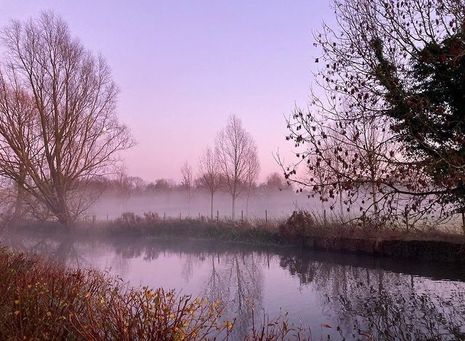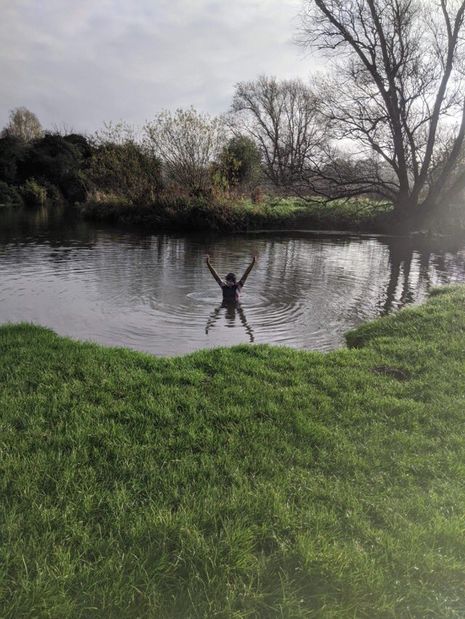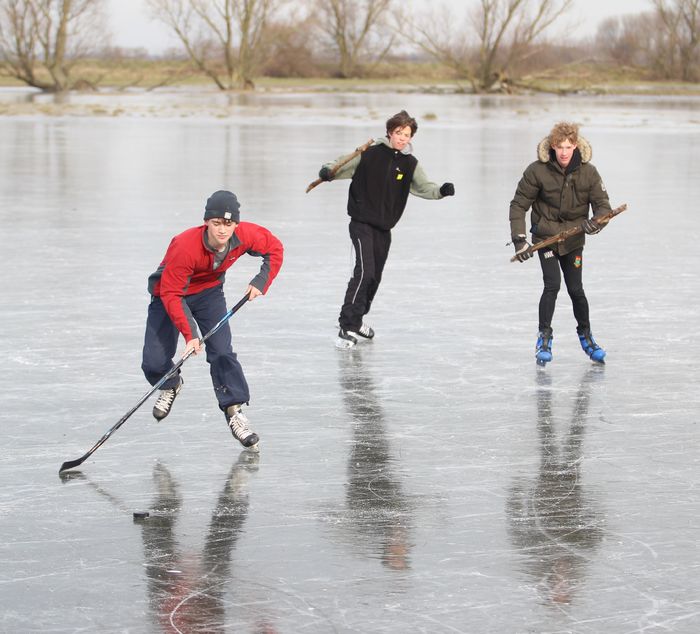The beauty of winter swimming in the Cam
Cold water swimming enthusiast Bella Biddle describes how, despite the dangers, a winter dip can do wonders for your health.

Before this winter, my memories of swimming in the Cam were of pre-lockdown Pimmsy picnics, as my year jumped off of rope swings and paddled about in the hot May week sun. When the first lockdown hit, the water was like a haven. I lived with housemates, and we swam all the way through that long summer heatwave that started in March and didn’t stop until September. When it was sunny, we would lounge around on the riverbanks and soak up fresh air and vitamin D, and when it was rainy I would swim alone in the muggy summer air and scream.
Now it’s 1°c and snowing outside, and the water is a breezy 3.1°c when I climb out from the Cam, bikini-clad and dripping. I open my phone to a text from a friend.
“Please tell me you’re not still swimming in the river, you silly girl.”
Spoiler alert: I am. Every day (almost), rain or shine, I pack up my towel and my bobble hat, I put on my bikini and my warm, fluffy Dryrobe and I cycle to Sheep’s Green, Grantchester Meadows or Newnham Riverbank Club, and I get in the Cam. Usually I take a friend, but sometimes I go alone. Bumping into other wild swimmers is one of the only opportunities I get to meet a community of older people and non-students in Cambridge, mostly women, who have also caught the cold-water swimming bug. Since I started almost a year ago, I have finally started to identify as one of them. They have given me advice on swimming spots, on snacks, on currents and on riverbank ladders. I’ve picked up tips and tricks like the number of minutes you can stay in the water when the temperature is sub-10°c, and which places the river floods after a storm, and I’ve shared my own opinions on neoprene socks (I think they’re good) and Weil’s disease (I think it’s bad). I’ve gone to Zoom socials with the Cambridgeshire Bluetits, and even dragged a few semi-willing first timers on early morning swimming dates. The river is seldom empty.
“The cold rush and the slow burn is the highlight of my day...”
On dry land though, people struggle to understand why I spend a little bit of time every day risking hypothermia for a quick rush. When you first get in the water at this time of year, it is so cold that your body starts to panic; your muscles contract, your lungs seize. It is so cold that it hurts a little bit all over, like tiny needles all over your skin. I’ve slid into the Cam before and cried because of the cold. When my college mates watch me waddle back through my icy plodge, damp and bedraggled, I totally understand the confusion. In the moments before I get in the water, sometimes I am confused as well.
When I started swimming, I thought I was using it to patch over other water sports that I couldn’t do in lockdown – or that I was looking for a bit of variety, but quickly I found that I couldn’t make it through a day without a dip. The icy shock as you get in, the slow five minutes as your body relaxes into the soak, and then the rush of warm as you get back out soothes your nervous system and reduces stress; you feel the high of endorphins entering your body as you get back out. Like a caffeine addict, I found myself tired and jittery without my morning dose of cold river water.

There is a myriad of scientific reasons to give cold water swimming a go. I could cite studies about improving dementia, or circulation, or muscle tone, or mental health, even libido. I could talk about cold water swimming as a form of hydrotherapy, or cite millennia of societies who recognise the holistic healing power of moving through natural water – from the Ancient Greek use of water as a healing agent, to the Jewish Mikvah. I could talk about the spiritual implications of feeling close to your water source, and I could just as easily talk about how visiting the river and wildlife and people that support and constitute my city every day makes me feel closer to my community. I could also talk about the fact that my shoulders are definitely stronger for swimming all summer, that my hip flexors are better aligned, and the fact that my asthmatic symptoms when I submerge myself are gone. But the reason that I find myself coming back to the Cam every day is simply because it makes me feel happier.
There are dangers. My worried summer swimmer friend was not wrong to worry. Cold water shock can kill you, as can hypothermia, and a number of waterborne diseases. At this time of year, storms, floodwater and currents can be complicated to understand and navigate, and diving into shallow water is the fourth leading course of spinal cord injury. Cold water swimming is an extreme sport, and should be respected.
“The winter Cam does not always look or feel welcoming, but she’s worth a visit.”
As the air gets warmer, for a long time the water will stay cold – make sure you that you wear appropriate kit (there is no shame in a wetsuit for those who have not built up cold-water tolerance over time!). Make sure that you take time to acclimatise to the temperature, and that you get out before your core temperature drops too low. Creating habit from lots of quick daily dips is far more likely to result in a positive experience wild swimming than forcing yourself through a long immersion at the beginning.
Bring warm layers, a hot drink and a snack; bring a bike to cycle quickly back for a warm shower. Bring a friend to watch you or join you, in case of an accident. Look at flooding charts, swim upstream first. Watch the current, and check that you have identified multiple points that you can climb out from. Pick a place to swim upstream of pollutants, leave wildlife alone, make sure you are far from any weirs or locks. Patch up open wounds before you swim.
But do not feel discouraged from giving cold water swimming a go. The cold rush and the slow burn is the highlight of my day, and the nature and the cycle and the people make the whole experience part of a ritual, which is totally sacred to my Cambridge experience. And as the days get longer, the air and the water gets warmer, I hope that I will see more people in the river. The winter Cam does not always look or feel welcoming, but she’s worth a visit.
 News / Eight Cambridge researchers awarded €17m in ERC research grants27 December 2025
News / Eight Cambridge researchers awarded €17m in ERC research grants27 December 2025 News / Downing investigates ‘mysterious’ underground burial vault 29 December 2025
News / Downing investigates ‘mysterious’ underground burial vault 29 December 2025 Lifestyle / Ask Auntie Alice29 December 2025
Lifestyle / Ask Auntie Alice29 December 2025 Sport / Hard work, heartbreak and hope: international gymnast Maddie Marshall’s journey 29 December 2025
Sport / Hard work, heartbreak and hope: international gymnast Maddie Marshall’s journey 29 December 2025 Interviews / Meet Juan Michel, Cambridge’s multilingual musician29 December 2025
Interviews / Meet Juan Michel, Cambridge’s multilingual musician29 December 2025










